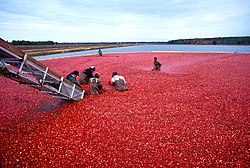Cookbook:Cranberry
| Cranberry | |
|---|---|
 | |
| Category | Fruits |
Cookbook | Recipes | Ingredients | Equipment | Techniques | Cookbook Disambiguation Pages | Ingredients

The cranberry is a small sour fruit. It comes in several varieties, which range across northern America, Europe, and Asia.
Characteristics
[edit | edit source]Cranberries are small, red, and quite tart once fully ripened.[1][2][3] They should be shiny and plump and range in color from bright light red to dark red. They are firm, containing edible seeds and a large amount of air. Cranberries are available fresh or dried, and the dried berries are often pre-sweetened with sugar.[4]
Seasonality
[edit | edit source]Cranberries are, for the most part, only grown in the northern hemisphere. The primary harvesting season is October through December, and they are available in various preserved forms throughout the rest of the year.[1][3]
Selection and storage
[edit | edit source]Ripe cranberries will bounce if they are in good condition.[5] Shriveled berries or those with brown spots should be avoided. Store fresh cranberries in the refrigerator, where they can last for several weeks.[2] As with all berries, if one starts getting soft and decaying, the others will quickly soften and decay also. Be sure to sort out the soft ones if you plan to store them for more than a few days. Cooked cranberries can last up to a month in a covered container in the refrigerator. Washed cranberries may be frozen for up to 1 year in airtight containers.[2] Dried cranberries have a very long shelf life of several months at room temperature.
Use
[edit | edit source]Due to their extreme tartness, cranberries are rarely eaten on their own. Instead, they are often sweetened and processed into baked goods, juice, dried fruit, and a jam or jelly called cranberry sauce.[2][5][6] They can also be candied to make a garnish,[4] and they pair very well with deeply savory dishes, such as those with roasted meats.[4][5]
No matter what preparation method you choose, cook cranberries only until they pop; overcooking gives them a bitter taste. Since cranberries are almost 90% water, do not thaw frozen cranberries before cooking them. Thawing will cause the fruit to break down, resulting in soft berries. Cranberries may be baked with a sweetener to make a topping or sauce. They are also good chopped with oranges to make a relish.
Recipes
[edit | edit source]References
[edit | edit source]- ↑ a b Rinsky, Glenn; Rinsky, Laura Halpin (2008-02-28). The Pastry Chef's Companion: A Comprehensive Resource Guide for the Baking and Pastry Professional. John Wiley & Sons. ISBN 978-0-470-00955-0.
- ↑ a b c d Friberg, Bo (2016-09-13). The Professional Pastry Chef: Fundamentals of Baking and Pastry. Wiley. ISBN 978-0-470-46629-2.
- ↑ a b The Chefs of Le Cordon Bleu (2011-12-02). Le Cordon Bleu Patisserie and Baking Foundations. Cengage Learning. ISBN 978-1-4390-5713-1.
- ↑ a b c "Hey Chef, What Can I Do With Cranberries?". Serious Eats. Retrieved 2024-05-13.
- ↑ a b c Davidson, Alan (2014-01-01). Jaine, Tom (ed.). The Oxford Companion to Food. Oxford University Press. doi:10.1093/acref/9780199677337.001.0001. ISBN 978-0-19-967733-7.
- ↑ Kipfer, Barbara Ann (2012-04-11). The Culinarian: A Kitchen Desk Reference. Houghton Mifflin Harcourt. ISBN 978-0-544-18603-3.
